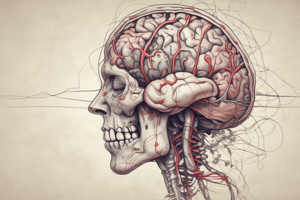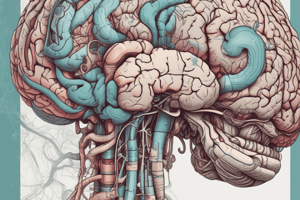Podcast
Questions and Answers
What is the primary function of the nervous system?
What is the primary function of the nervous system?
- To control the immune system
- To transmit signals to and from parts of the body (correct)
- To regulate body temperature
- To produce hormones
What is the purpose of the meninges in the nervous system?
What is the purpose of the meninges in the nervous system?
- To transmit nerve signals
- To protect the central nervous system (correct)
- To produce cerebrospinal fluid
- To regulate blood flow
What is the significance of the blood-brain barrier in the nervous system?
What is the significance of the blood-brain barrier in the nervous system?
- It helps to transmit nerve signals
- It regulates the body's temperature
- It regulates blood pressure
- It protects the central nervous system from toxins (correct)
How often will seminars take place in the course?
How often will seminars take place in the course?
What is the purpose of the seminar booklet in the course?
What is the purpose of the seminar booklet in the course?
What proportion of the course grade is comprised of exam questions?
What proportion of the course grade is comprised of exam questions?
What is the main function of the cerebrospinal fluid (CSF)?
What is the main function of the cerebrospinal fluid (CSF)?
What is the primary purpose of the blood-brain barrier?
What is the primary purpose of the blood-brain barrier?
What is the main difference between the autonomic nervous system and the somatic nervous system?
What is the main difference between the autonomic nervous system and the somatic nervous system?
What type of nerves carry signals away from the central nervous system?
What type of nerves carry signals away from the central nervous system?
What is the term for the barrier that prevents toxic substances from crossing into the spinal cord?
What is the term for the barrier that prevents toxic substances from crossing into the spinal cord?
What is the term for the nerves that carry signals to the central nervous system?
What is the term for the nerves that carry signals to the central nervous system?
What percentage of the body's oxygen supply does the brain use?
What percentage of the body's oxygen supply does the brain use?
What is the approximate surface area of the brain if all the wrinkles were ironed out?
What is the approximate surface area of the brain if all the wrinkles were ironed out?
What is the approximate weight of the brain at birth?
What is the approximate weight of the brain at birth?
How many neurons are estimated to be in the human brain?
How many neurons are estimated to be in the human brain?
What is the name of the largest tract connecting the two hemispheres of the brain?
What is the name of the largest tract connecting the two hemispheres of the brain?
What is the approximate speed at which a message travels from the brain to the muscles?
What is the approximate speed at which a message travels from the brain to the muscles?
What is the term for a groove or furrow on the surface of the brain?
What is the term for a groove or furrow on the surface of the brain?
What is the primary function of the structures in the brain stem?
What is the primary function of the structures in the brain stem?
What is the term for a ridge or fold on the surface of the brain?
What is the term for a ridge or fold on the surface of the brain?
What is the division of the brain that contains the Limbic system and Diencephalon?
What is the division of the brain that contains the Limbic system and Diencephalon?
What is the term for a long narrow crack in the brain?
What is the term for a long narrow crack in the brain?
How many major divisions of the brain are there?
How many major divisions of the brain are there?
Which part of the brain is responsible for controlling facial muscles, tongue, and eyes?
Which part of the brain is responsible for controlling facial muscles, tongue, and eyes?
What is the role of the Pons in the brain?
What is the role of the Pons in the brain?
Which part of the brain is involved in the control of the cardiovascular system?
Which part of the brain is involved in the control of the cardiovascular system?
What is the function of the Cerebral cortex?
What is the function of the Cerebral cortex?
What is the role of the Tectum in the brain?
What is the role of the Tectum in the brain?
Which part of the brain is involved in emotion, pleasure, and memory of emotional events?
Which part of the brain is involved in emotion, pleasure, and memory of emotional events?
Flashcards are hidden until you start studying
Study Notes
Neuroanatomy and The Nervous System
- The nervous system coordinates voluntary and involuntary actions and transmits signals to and from parts of the body.
- The vertebrate nervous system has two major divisions: the central nervous system (CNS) and the peripheral nervous system (PNS).
The Central Nervous System (CNS)
- The CNS is protected by:
- Skull and spine
- Meninges (layers of protective tissue, including cerebrospinal fluid)
- Blood-brain barrier
- Meninges consist of:
- Dura mater (hard/tough mother)
- Arachnoid mater or membrane (spider/web-like membrane)
- Pia mater (pious mother)
The Brain
- An adult brain weighs about 1.5 kg (3.5 lbs), approximately the same as a Chihuahua dog.
- The brain is greedy, using 20% of the body's oxygen supply and 20-30% of the body's energy.
- The brain contains approximately 86 billion neurons, each with about 10,000 synapses, resulting in 86 trillion synaptic connections.
- A message for action travels from the brain to muscles at a speed of around 250 miles per hour.
- If ironed out, the brain would have an area of about 0.23 square meters (2.5 square feet).
Hemispheres and Cerebral Cortex
- The brain is divided into two halves called hemispheres, connected by tracts (cerebral commisures).
- The largest tract is the corpus callosum.
- The hemispheres are covered by a layer of tissue known as the cerebral cortex, which is deeply convoluted.
Brain Functions
- The brain processes a huge amount of information in a remarkably efficient way.
- The cerebral cortex receives information and routes it to where it needs to go.
- The brain is involved in:
- Modulating motor commands
- Precise skilled movements
- Control of facial muscles, tongue, and eyes
- Control of the cardiovascular system, respiration, muscle tone, swallowing, and coughing
Brain Regions
- Hindbrain: auditory, vestibular (balance), and somatosensory (movement, balance, posture) information.
- Midbrain: involved in sleep/arousal, eye movement, and movement.
- Forebrain:
- Basal ganglia: a group of subcortical nuclei
- Limbic system: emotion, pleasure, and memory of emotional events
- Cerebral cortex: grey matter, responsible for thinking, intelligence, planning, personality, language, and motor function
Cerebrospinal Fluid (CSF)
- CSF fills the subarachnoid space, central canal of the spinal cord, and cerebral ventricles.
- CSF supports and cushions the brain.
Blood Brain Barrier
- Prevents toxic substances from crossing from the blood to the brain.
- Unlike other capillaries in the body, they have tight junctions to prevent molecules from moving from the inside of the capillary to the outside.
The Peripheral Nervous System (PNS)
- Divided into two parts: autonomic nervous system (ANS) and somatic nervous system (SNS).
- Autonomic nervous system (ANS): regulates the internal environment, involuntary actions.
- Somatic nervous system (SNS): interacts with the external environment, voluntary actions.
Afferent and Efferent Nerves
- Afferent nerves: carry signals to the central nervous system.
- Efferent nerves: carry signals away from the central nervous system.
Brain Terms
- Sulcus (sulci): a groove or furrow on the surface of the brain.
- Gyrus (gyri): a ridge or fold on the surface of the brain.
- Fissure: a long narrow crack (a deep sulcus).
- Lobe: a roundish, flattish projecting or hanging part of something, often one of two or more such parts divided by a fissure.
Brain Divisions
- The brain has five major divisions located in three areas: forebrain, midbrain, and hindbrain.
- Brain structure and function are conserved across bilaterally symmetrical animals.
Studying That Suits You
Use AI to generate personalized quizzes and flashcards to suit your learning preferences.




